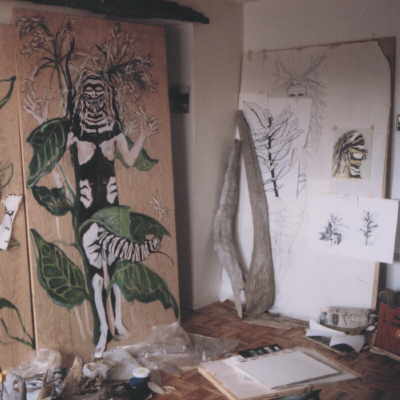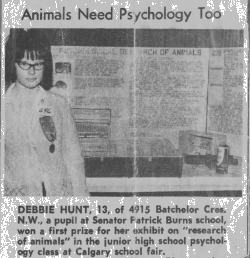
|
Questions about the
installation Milkweed Patch
|
|

|
|
|
|
|

|
|
|
|
|
|

|
|
|
|
|
|

|
|
|
|
|
|
|
|
|
|
|
|
Where did you get the
idea?
|
|
|
I always loved science, but we were told that one had to
choose between the arts and the sciences. I chose art
because I knew my imagination would always be a distraction,
perhaps to the point of insanity, if I couldn't somehow
harness it.
Milkweed Patch began with watching
caterpillars. When I was a kid, Toronto entomologist Fred
Urquhart had sent out a call for volunteers to tag monarchs,
to find out where they migrate to in the fall. A lot of the
people who ended up being important to that research were
children, but I wasn't one of them. There are no monarchs in
Alberta, so I practised putting sticky labels on a few
unfortunate common sulphur butterflies. I was ecstatic to
see them when I moved to Ontario, but by then I was a busy
adult person, with no time to be proccupied with
butterflies.
|

|
|
But in 1989, during an emotional break-down, a friend let
me spend a lot of time at her home in the country. That year
the monarchs were abundant, and their chrysali festooned the
eaves like little jade lanterns. I had the time to watch the
monarchs closely. I began to identify with their lives. So
Milkweed Patch began with drawings and photos
made on Manitoulin Island in 1989 and 1990. It was shown as
a work in progress at Cedar Ridge Gallery in Scarborough,
Ontario and the Cornwall (Ontario) Regional Art Gallery. It
made its debut in its final form at A Space Gallery in 1999,
where the pictures were taken that are featured on this
web-site.
My educational work is also based on the process that
created Milkweed Patch. Through my educational
projects I try to let children know, not that they have to
rescue Nature from us, but that Nature is there for them, if
only in a crack in the sidewalk. She can help them through
hard times, teach and entertain them. They don't have to
have gobs of money to feel fully alive, to create.
|
|

|
|
|
If you like butterflies so much,
how can you use silk? To make the silk you used in your
artwork, millions of pupae were boiled alive inside their
cocoons!
|
|
I wanted to use silk for its beauty, and the fact that it
is a real insect product. Some artists, such as Canada's
Aganetha Dyck, collaborate with animals like beavers or bees
to make artwork. Milkweed Patch did not
involve a collaboration, but a large-scale sacrifice of
insect life. This was appropriate for an artwork that, among
other things, tries to confront our fear of death.
Milkweed Patch grew from grief caused
by a large-scale human loss during the AIDS epidemic: one
that swept through my friendships from about 1987 to 1993
and that is still growing in Africa and worldwide. Often my
personal mourning combined with fear for the fate of the
migrant monarch butterflies. Insects died, people died
during the making of this work. In a real way, the insect
tragedy represents other losses, including personal ones
experienced by viewers and environmental disasters such as
the large winter kills due to deforestation of the monarchs'
Mexican refuge.
Most of all, my purpose was to create the opportunity to
make an important point. Animals generally don't become
extinct because we use them, but because we destroy the
habitats in which they live. I respect vegetarians,
especially in view of the tremendous cruelty, waste and
habitat destruction that accompany our industrial farming
and fishing methods. But the use of animals for food and
clothing needn't involve any of this. Aboriginal traditions
teach us that respectful and sustainable use of the land,
not abstention, is basic to an ecologically sustainable
economy. They teach that we can take with respect,
gratitude, love and intelligence.
Herein lies the key to united action among
environmentalists, First Nations and resource workers such
as loggers, trappers, farmers and fishermen. Many of us have
a "Sunday" attitude toward the earth. We want a few pristine
areas set aside for our enjoyment, but we figure our farms
and cities are hopeless. This is not the case. The continued
existence of large areas of true wilderness is necessary for
the health of all the living systems we depend on: air,
weather, water, soil, the regeneration of our foodplants and
animals. But wilderness has always included a human
presence.
And if we want to improve our health now and permit today's
children to have a real life and a living, we must use the
land with respect always. All over the world, traditional
methods have been in use that filled the needs of dense
populations century after century. Over the last thirty
years, new technologies and working methods have been
developed for industry, farming, energy and civic design
that would create good jobs that solve problems and perform
vital services.
The way that resources are taken now results in layoffs of
millions of workers as a fishery or forest is destroyed, but
knowledge from the past and the present exists to replace
needlessly destructive ways of managing economies. The use
of silk in Milkweed Patch makes the subtle but
vital point that respect for life needn't force one to live
like a Jain monk. In any but the most short-sighted
scenarios, ecological sense also makes economic sense.
|
|

|
|
|
There seems to have been a
native influence on your art.
|
|
|
There definitely has been. But nobody had to tell me that
it is disrespectful to try to imitate someone else's
culture, or that insights must be earned and not borrowed. I
knew I would lose my friendships among native people if I
exploited our relationships in any way. So I'm concerned
about the issue of cultural appropriation.
I benefited greatly from knowing more than one culture, and
the chief benefit is to know that I wasn't crazy to feel
uncomfortable with aspects of my own. My culture isn't
reality: it's my culture. It's the legacy that I was given,
and that I can influence as I pass it on. That awareness
helps me to accept myself and to explore reality with
greater freedom, though often with some discomfort. I use
what I learn to try to develop and heal my own culture so
that it will stop being so destructive.
Most native teachings are freely shared, and two were of
special benefit to me. One was the belief, not metaphorical
at all, that plants and animals are our healers and
teachers. This confirmed the way I had always felt toward
other creatures, and was a needed source of strength.
Another very helpful teaching was that it's our duty to use
the gifts the creator sent us into the world with. In a
lifelong struggle with creative block caused by my own
culture's contempt for artists, that was the mantra that
enabled me to sit down and start moving my hands each time I
worked on a piece.
|
|
Originally, the drawings and paintings I created under
these insights bore too much resemblance to various types of
aboriginal art. (See Humanoid Skull, at right)
I abandoned that approach to try to make an original
statement. As I explored my own identity, I remembered the
ten-year-old who wanted to be a scientist. Returning to my
original observations of the monarch butterfly, I began to
base my drawings on biological illustration. It was
gratifying to realize that biology's first and best
technique, the observation of wild nature, is also the basis
of aboriginal teachings worldwide!
|

|
|
I finally was beginning to like what I was doing, but the
small scale of my drawings made them seem more precious than
transformative, like fairy tale and nature illustrations. In
order to help the viewer sense the power and terror of
metamorphosis, and to firm up the association with human
life cycle, I scaled the project up to human size. Without
my conscious effort, other cultural references seep in, from
Carl Jung to Odilon Redon to Lewis Carroll. The process was
long and and the results are kind of strange. But after
watching many people walk through the installation, I don't
doubt that Milkweed Patch is the complex yet
accessible, all-ages experience I wanted it to be.
I'm impatient with those who would dismiss this honest
struggle by labelling my concerns as "politically correct".
Respecting other peoples' boundaries forced me to dig deeply
into myself and my culture, always a rich creative process.
I feel that through this pursuit I managed to hit an
aquifer: the relationship to nature that sustains us all and
that we are all entitled to. It's so important for my
industrialized culture to find ways to make that connection
in all fields: science, ethics, social organization.
Aboriginal cultures tell us that a rich life is possible, in
harmony with the earth. But we can't save ourselves by
playing Indian. Other cultures can teach and guide us, but
my people must dig our own way out of the immense darkness
we've created.
This was a long answer to a short question, but its an
important question.
|
|
|
|
|






